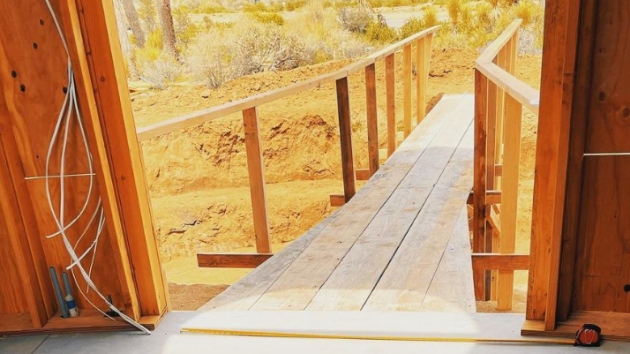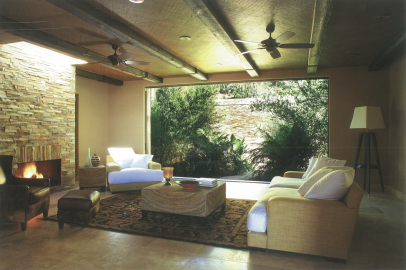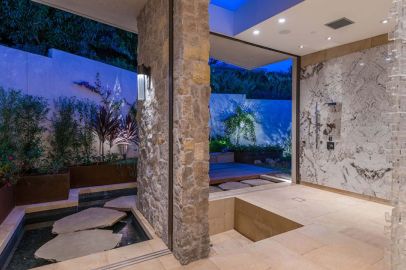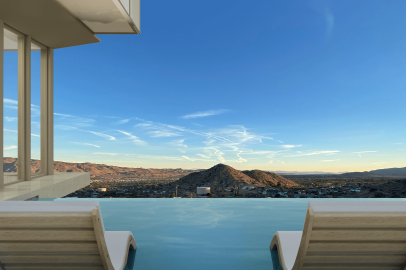Biophilic Design in Architecture

Biophilic design in architecture is an approach that integrates natural elements into the built environment. The practice is based on the premise that humans have an innate connection with nature and that incorporating natural elements into the design can positively impact the well-being of people. We feel that Dean Larkin Design is a prime example of an organization that has embraced biophilic design principles. We love to incorporate nature into our designs, often choosing design features that incorporate natural light, open space, and water.
What is Biophilic Design?
Biophilic design is a relatively new concept that has gained popularity in recent years. The term refers to the integration of nature into architecture and interior design. The term “biophilia” was coined by the biologist E.O. Wilson in his book Biophilia and refers to the idea we mentioned; that humans have an instinctive and innate connection to nature. Biophilic design seeks to enhance that connection by incorporating natural elements, such as light, water, plants, and natural materials, into the built environment.
What are the Benefits of Biophilic Design in Architecture?
Biophilic design has been shown to have numerous benefits. The use of the natural elements has been linked to better physical health, cognitive function, and emotional well-being Biophilic design offers a number of benefits for businesses too. Studies have shown that biophilic design can lead to increased productivity, reduced stress levels, and improved employee morale. Biophilic design can also help to attract and retain top talent, and can improve the overall image of a business.
Dean Larkin Design’s Biophilic Design Approach
Our architecture and interior design firm specializes in luxury residential and commercial projects. The firm has a reputation for creating innovative and functional spaces that are also aesthetically pleasing. We want our clients to connect with and really enjoy their space. Creating spaces that promote a connection to nature and enhance the overall well-being of the occupants, or biophilic design, is in our DNA. Below are some of the ways we bring nature into our designs.
Natural Materials
One way that we incorporates biophilic design principles into our projects is through the use of natural materials. As a firm that loves contemporary design, we often use materials such as wood, stone, and glass to create a sense of warmth and connection to the natural environment. This approach can be seen in the firm’s Latimer project, where the use of glass, natural walnut, and aged oak floors and ceilings creates a modern aesthetic that merges seamlessly with the surrounding landscape. In fact, a “lake” appears to enter the house under the main stairs to further blur the boundaries between inside and outside.
Light and Motion
Another way we incorporate biophilic design principles is through the use of natural light. The firm often incorporates large windows and skylights into their designs to maximize the amount of natural light that enters a space. We also pay attention to the position of the sun in relation to the home and where residents will be at certain times of day. In our Faith Project in Yucca Valley, we positioned the house so that its occupants would get great views of the mountains. And the sun’s movement in the desert really reflects beautifully off of those mountains. This approach creates a sense of openness and connection to the surrounding landscape.


Another fun example of natural lighting in our Faith project is this skylight, that allows the sun to shine in a circle right at the doorway to the home. We just celebrated the Equinox at this project, which is still under construction.
Plants and Water Features
Dean Larkin Design also incorporates biophilic design principles into their landscaping designs. The firm often incorporates plants and water features into their designs to create a sense of tranquility and connection to nature. The use of plants in this design creates a serene and peaceful atmosphere.
Water features, inside and outside, also add to a feeling of tranquility. In the water feature pictured, plants line a privacy wall, and a river with walking stones surrounds the bathroom’s sunken tub. We think this lends a very private, luxurious, and peaceful feel to the bath area.



The final image above shows a zero edge pool, another water feature. In the right position, the home’s occupants get the luxury of a beautiful, cool pool while enjoying the amazing view from the home’s patio.
Contact Dean Larkin for Exceptional Contemporary Biophilic Design in California
If you are interested in learning more about biophilic design in architecture and indoor/outdoor design elements, we would love to hear from you. Dean Larkin Design was established in Los Angeles in 1999 and this architectural design company maximizes the intrinsic potential of a location, including its available natural light sources. Dean Larkin is very familiar with both historical and contemporary design in the entire Los Angeles area, and the firm endeavors to achieve a complexity that is multi-layered with an effortless elegance. For a design that is modern and innovative, unlocks your location’s innate potential by making specific use of light, views and more, and uniquely designed for the way you live, contact Dean Larkin for a consultation.